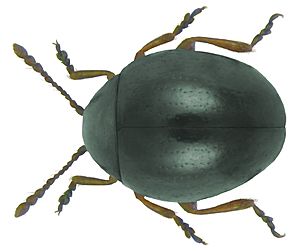Mniophila facts for kids
Quick facts for kids Mniophila |
|
|---|---|
 |
|
| Mniophila muscorum | |
| Scientific classification | |
| Kingdom: | |
| Phylum: | |
| Class: | |
| Order: | |
| Family: | |
| Genus: |
Mniophila
Stephens, 1831
|
Mniophila is a small group of tiny beetles. They belong to a big family called leaf beetles. These beetles are found almost everywhere across Europe. They are known for eating plants.
Contents
Meet the Mniophila Beetles
Mniophila beetles are very small insects. They are part of the larger leaf beetle family. These tiny creatures spend their lives on plants. They get their food from leaves. There are only two known types, or species, of Mniophila beetles.
What are Leaf Beetles?
Leaf beetles are a huge family of insects. Their scientific name is Chrysomelidae. There are more than 35,000 different kinds of leaf beetles around the world. They are called leaf beetles because most of them eat leaves. They can be found in many different shapes and colors.
Why are They Important?
Leaf beetles play a role in nature. They help control plant growth. They also serve as food for other animals. This makes them a part of the food chain.
Where Do Mniophila Live?
The two species of Mniophila beetles live in Europe. They can be found in many different countries there. They prefer places where their favorite plants grow. These places often include forests, meadows, and gardens.
Their Habitat
Mniophila beetles live in various plant environments. They are often found on specific types of plants. These plants provide them with food and shelter. They blend in well with their surroundings.
Life Cycle of a Beetle
Like all beetles, Mniophila goes through a complete life cycle. This means they change a lot as they grow. It starts as an egg and ends as an adult beetle.
Egg Stage
The female beetle lays tiny eggs. She usually places them on a plant. This plant will be food for the young beetles. The eggs are often very small and hard to see.
Larva Stage
After hatching, the egg becomes a larva. Larvae are like tiny worms. They spend their time eating and growing. They shed their skin several times as they get bigger. This process is called molting.
Pupa Stage
Once the larva is big enough, it changes into a pupa. The pupa stage is a resting period. During this time, the larva transforms into an adult beetle. It might be hidden in the soil or on a leaf.
Adult Stage
Finally, the adult beetle emerges from the pupa. The adult beetle can fly and reproduce. Its main job is to find a mate and lay eggs. This starts the life cycle all over again.

